
Tidying Data 🧹
MATH/COSC 3570 Introduction to Data Science
Department of Mathematical and Statistical Sciences
Marquette University
Grammar of Data Tidying
Grammar of Data Tidying
Have data organised in an unideal way for our analysis
Want to re-organise the data to carry on with our analysis
The goal of tidyr is to help you tidy your data via
pivoting for going between wide and long data
separating and uniting character columns
clarifying how
NAs should be treatednesting and unnesting columns
Wide Data
To tidy your data, (1) figure out what the (column) variables and (row) observations are; (2) resolve one of two common problems:
One (column) variable spreads across multiple columns
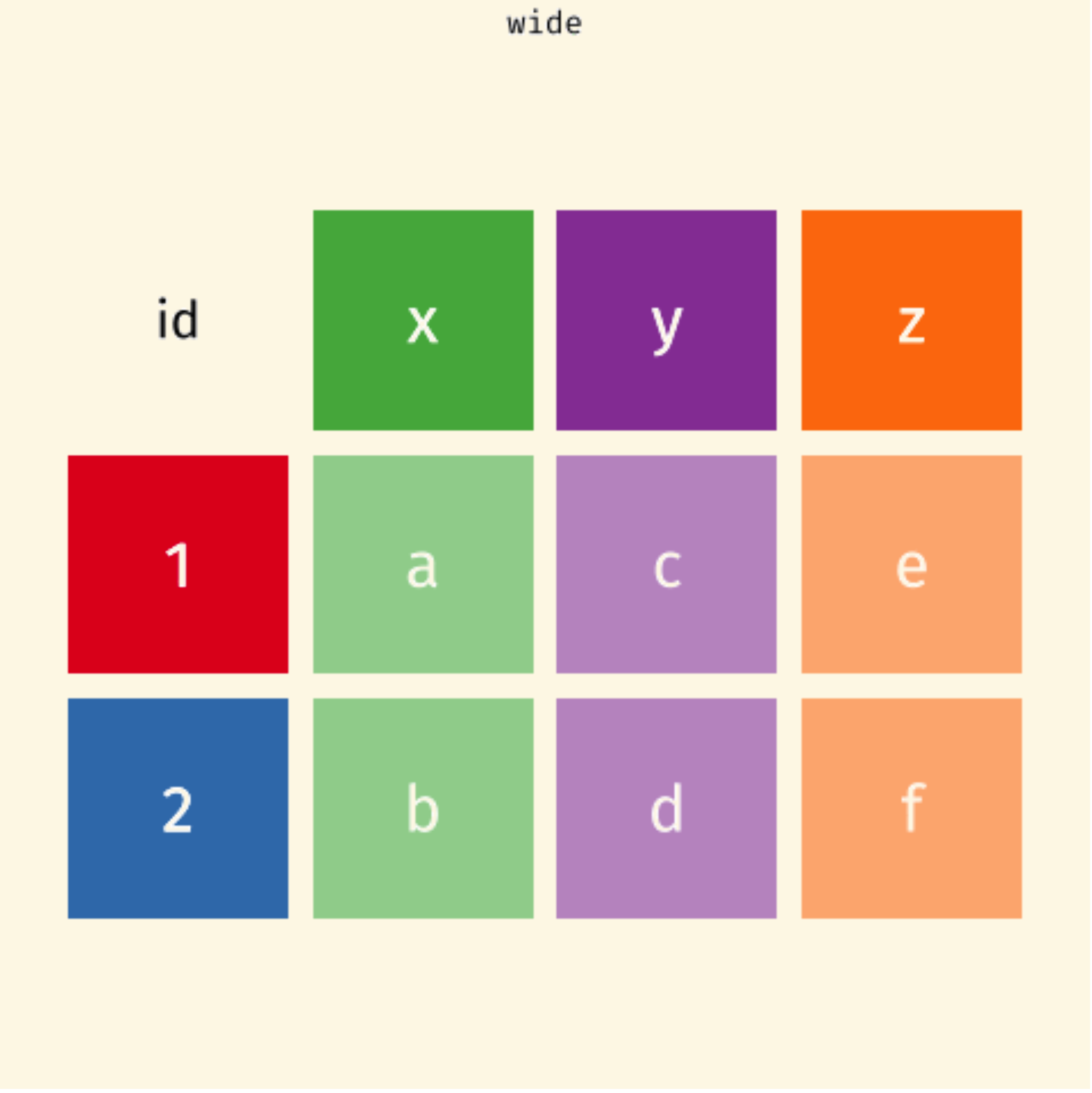
customers <- read_csv("./data/sales/customers.csv")wider (\(2 \times 4\))
more columns than we want!
customers# A tibble: 2 × 4
customer_id item_1 item_2 item_3
<dbl> <chr> <chr> <chr>
1 1 bread milk banana
2 2 milk toilet paper <NA> - We may want one single column variable
itemshowing all purchased times.
Long Data
One (row) subject is scattered across multiple rows

longer (\(6 \times 3\))
more rows than we want!
# A tibble: 6 × 3
customer_id item_no item
<dbl> <chr> <chr>
1 1 item_1 bread
2 1 item_2 milk
3 1 item_3 banana
4 2 item_1 milk
5 2 item_2 toilet paper
6 2 item_3 <NA> We may want each row corresponds to one single customer, not one single purchased item.
Which data format we adopt depends on our own research question.
pivot_longer() and pivot_wider()
To transform our data to the one we want, we use
pivot_longer()andpivot_wider().-
Starts with a data set,
pivot_longer()``lengthens” data, adding more rows and decreasing the number of columns.pivot_wider()``widens” data, adding more columns and decreasing the number of rows.
pivot_longer() and pivot_wider()
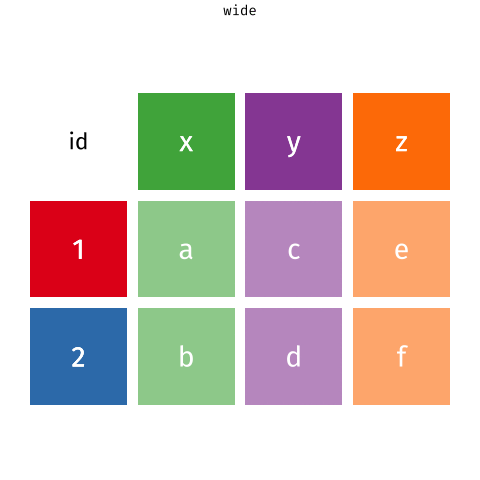
Data: sales/customers.csv
customers <- read_csv("data/sales/customers.csv")wider (\(2 \times 4\))
more columns
customers# A tibble: 2 × 4
customer_id item_1 item_2 item_3
<dbl> <chr> <chr> <chr>
1 1 bread milk banana
2 2 milk toilet paper <NA> longer (\(6 \times 3\))
more rows by pivot_longer()
# A tibble: 6 × 3
customer_id item_no item
<dbl> <chr> <chr>
1 1 item_1 bread
2 1 item_2 milk
3 1 item_3 banana
4 2 item_1 milk
5 2 item_2 toilet paper
6 2 item_3 <NA> pivot_longer()
data: data framecols: columns to pivot into longer format (1960, 1970, 2010)
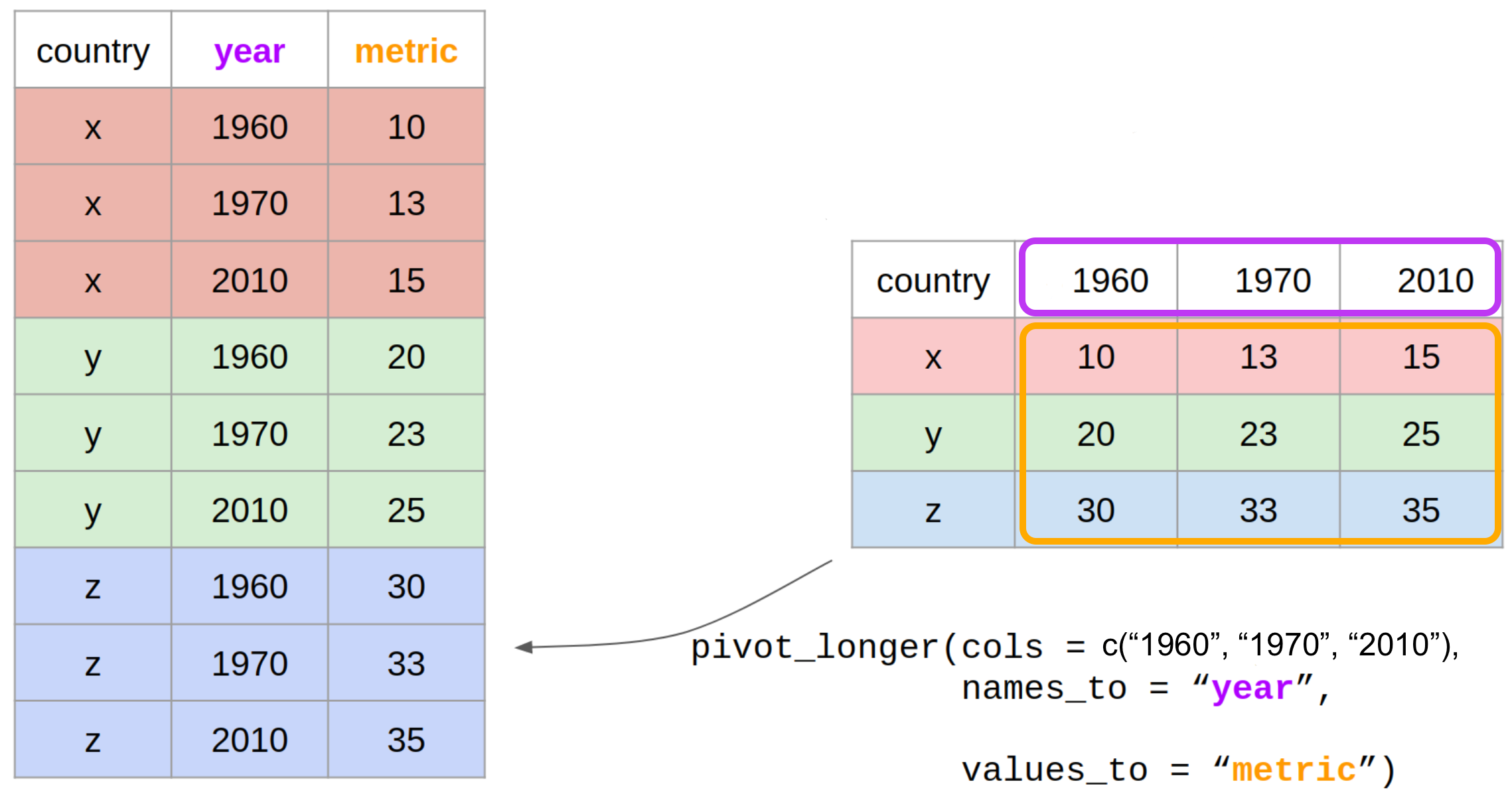
pivot_longer()
-
names_to: name of the column where column names of pivoted variables go (year)

pivot_longer()
-
values_to: name of the column where data values in pivoted variables go (metric)

customers \(\rightarrow\) purchases
customers# A tibble: 2 × 4
customer_id item_1 item_2 item_3
<dbl> <chr> <chr> <chr>
1 1 bread milk banana
2 2 milk toilet paper <NA> purchases <- customers |> pivot_longer(
# variables item_1 to item_3
# to be pivoted into longer format
cols = item_1:item_3,
# col name of the names of item_1:item_3
# item_1 item_2 and item_3
names_to = "item_no",
# col name of the values of item_1:item_3
values_to = "item"
)purchases# A tibble: 6 × 3
customer_id item_no item
<dbl> <chr> <chr>
1 1 item_1 bread
2 1 item_2 milk
3 1 item_3 banana
4 2 item_1 milk
5 2 item_2 toilet paper
6 2 item_3 <NA> In customers data,
Names item_1, item_2, item_3 are values of variable
item_noinpurchasesValues bread, milk, etc are values of variable
iteminpurchases
Why Pivot?
- The next step of your analysis needs it.
- The new
purchasesdata set and thepricesdata can now be joined together with the common key variableitem.
prices <- read_csv("./data/sales/prices.csv")
prices# A tibble: 5 × 2
item price
<chr> <dbl>
1 avocado 0.5
2 banana 0.15
3 bread 1
4 milk 0.8
5 toilet paper 3 purchases |>
left_join(prices) #<<# A tibble: 6 × 4
customer_id item_no item price
<dbl> <chr> <chr> <dbl>
1 1 item_1 bread 1
2 1 item_2 milk 0.8
3 1 item_3 banana 0.15
4 2 item_1 milk 0.8
5 2 item_2 toilet paper 3
6 2 item_3 <NA> NA pivot_wider()
data: data framenames_from: which column variable in the long format contains the what should be column names in the wide format (year)

pivot_wider()
data: data framevalues_from: which column variable in the long format contains the what should be values in the new columns in the wide format (metric)

purchases \(\rightarrow\) customers
purchases# A tibble: 6 × 3
customer_id item_no item
<dbl> <chr> <chr>
1 1 item_1 bread
2 1 item_2 milk
3 1 item_3 banana
4 2 item_1 milk
5 2 item_2 toilet paper
6 2 item_3 <NA> purchases |>
pivot_wider(
names_from = item_no,
values_from = item
) # A tibble: 2 × 4
customer_id item_1 item_2 item_3
<dbl> <chr> <chr> <chr>
1 1 bread milk banana
2 2 milk toilet paper <NA> 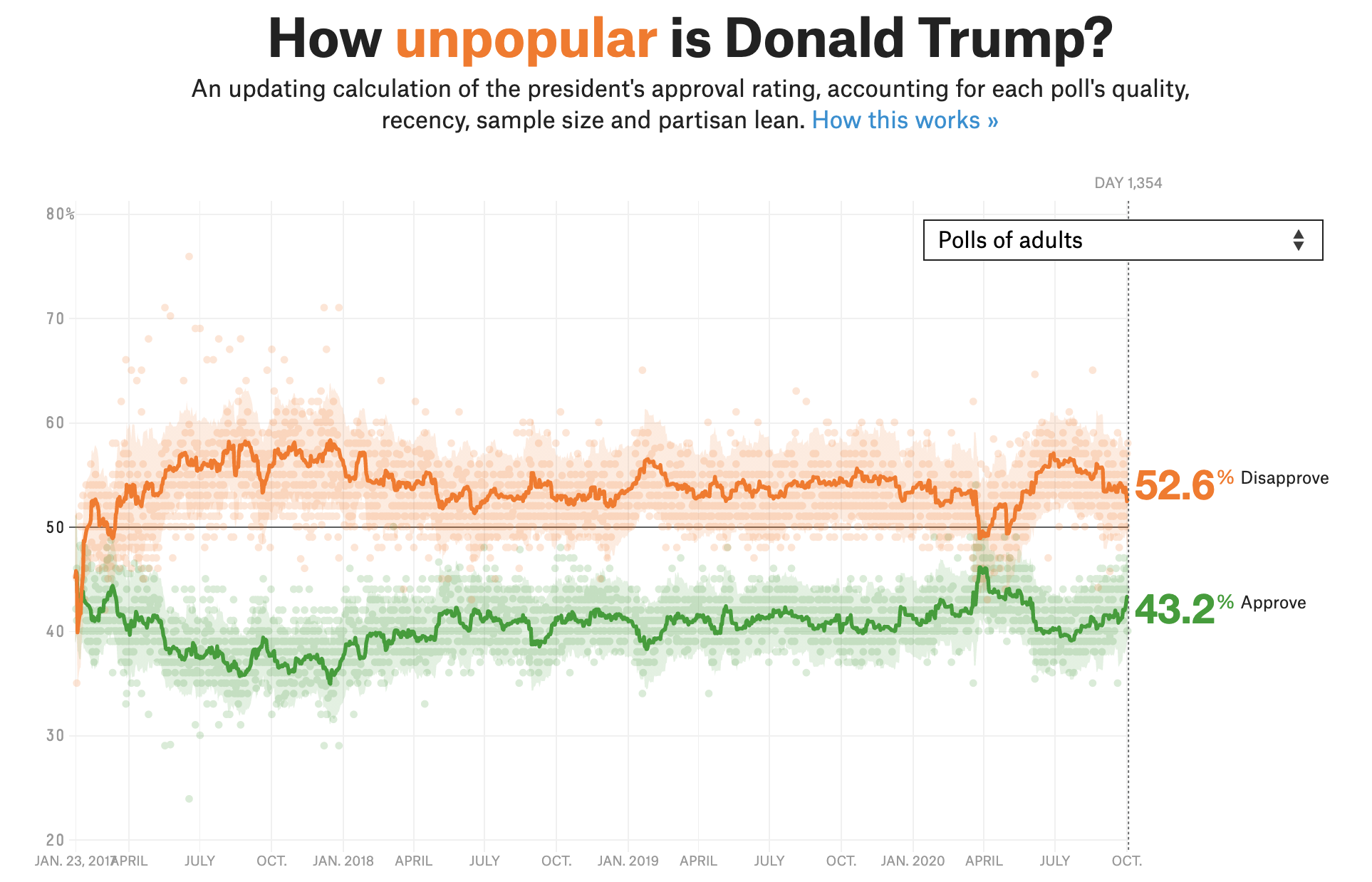
17-tidyr
In lab.qmd ## Lab 17 section,
Import
trump.csv. Call ittrump_dataas below on the left.Use
pivot_longer()to transformtrump_datainto the data settrump_longeron the right.
trump_data# A tibble: 2,702 × 4
subgroup date approval disapproval
<chr> <date> <dbl> <dbl>
1 Voters 2020-10-04 44.7 52.2
2 Adults 2020-10-04 43.2 52.6
3 Adults 2020-10-03 43.2 52.6
4 Voters 2020-10-03 45.0 51.7
5 Adults 2020-10-02 43.3 52.4
6 Voters 2020-10-02 44.5 52.1
# ℹ 2,696 more rows# A tibble: 5,404 × 4
subgroup date rating_type rating_value
<chr> <date> <chr> <dbl>
1 Voters 2020-10-04 approval 44.7
2 Voters 2020-10-04 disapproval 52.2
3 Adults 2020-10-04 approval 43.2
4 Adults 2020-10-04 disapproval 52.6
5 Adults 2020-10-03 approval 43.2
6 Adults 2020-10-03 disapproval 52.6
# ℹ 5,398 more rowsBONUS 💷: Use trump_longer to generate a plot like the one below.
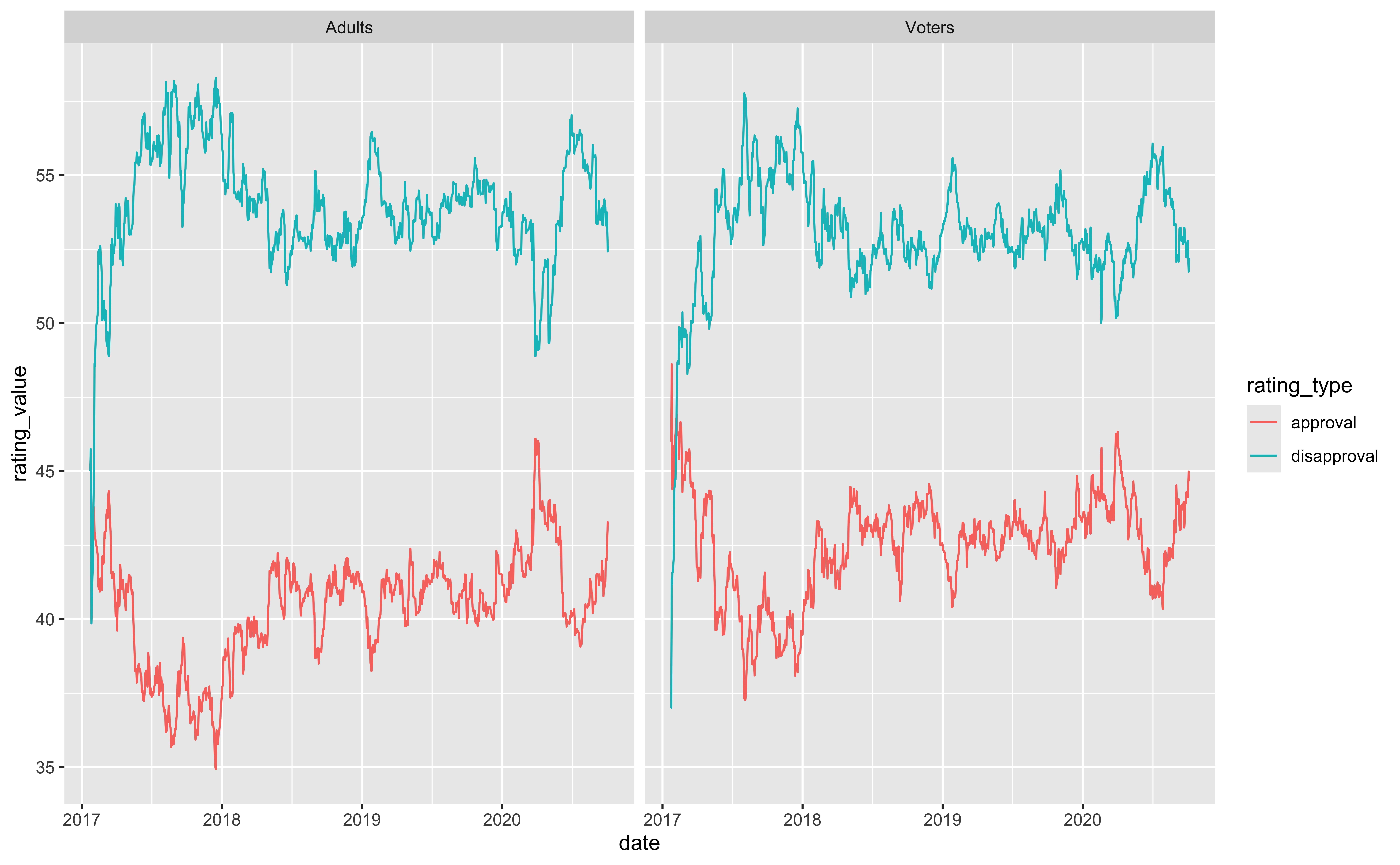
Pivoting
pd.melt()
pd.pivot()
pd.melt()
customer_id item_1 item_2 item_3
0 1 bread milk banana
1 2 milk toilet paper NaNpurchases = customers.melt(id_vars=['customer_id'],
value_vars=['item_1', 'item_2', 'item_3'],
var_name='item_no', value_name='item')
purchases customer_id item_no item
0 1 item_1 bread
1 2 item_1 milk
2 1 item_2 milk
3 2 item_2 toilet paper
4 1 item_3 banana
5 2 item_3 NaNpd.pivot()
customer_id item_no item
0 1 item_1 bread
1 2 item_1 milk
2 1 item_2 milk
3 2 item_2 toilet paper
4 1 item_3 banana
5 2 item_3 NaNitem_no item_1 item_2 item_3
customer_id
1 bread milk banana
2 milk toilet paper NaN